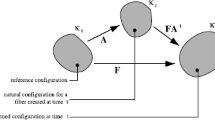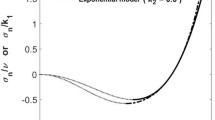Abstract
We discuss a ubiquitous intriguing issue that arises in the mechanics of fibrous soft materials, namely the occurrence of a “magic angle” associated with the fiber direction which gives rise to special features of the mechanical response. Classically, the magic angle concept arose in connection with hydrostatic skeletons or muscular hydrostats such as the common worm, octopus arm, or elephant trunk. It also arises in the field of soft robotics in connection with artificial muscles as well as in nuclear magnetic resonance. Such angles also occur in analysis of the mechanical behavior of fiber-reinforced incompressible elastic soft solids. In this context, the magic angle concept occurs most commonly in structural elements composed of circular cylindrical tubes or solid cylinders reinforced by helically wound fibers. An everyday example of the former is the common garden hose. The fibers can be inextensible as in reinforced rubber or extensible such as collagen fibers in soft tissue. Fibers orientated at the magic angle result in quasi-isotropic mechanical response and can lead to material instability.




Similar content being viewed by others
References
Horgan C.O., Murphy J.G., Saccomandi, G.: The complex mechanical response of anisotropic materials in simple experiments. Int. J. Nonlin. Mech. 106, 274–279 (2018)
Goriely, A., Tabor, M.: Rotation, inversion and perversion in anisotropic elastic cylindrical tubes and membranes. Proc. Roy. Soc. A. 469, 20130011 (2013)
Goriely, A.: The Mathematics and Mechanics of Biological Growth. Springer, New York (2017)
Cowey, J.B.: The structure and function of the basement membrane muscle system in Amphiporus lactifloreus (Nemertea). Quart. J. Micr. Sci. 93, 1–15 (1952)
Horgan, C.O., Murphy, J.G.: Magic angles for fibrous incompressible elastic materials. Proc. Roy. Soc. A. 474, 20170728 (2018)
Clark, R.B., Cowey, J.B.: Factors controlling the change of shape of certain nemertean and turbellarian worms. J. Exp. Biol. 35, 731–748 (1958)
Kim, D., Segev, R.: Various issues raised by the mechanics of an octopus’ arm. Math. Mech. Solids 22, 1588–1605 (2017)
Demirkoparan, H., Pence, T.J.: Magic angles for fiber reinforcement in rubber-elastic tubes subject to pressure and swelling. Int. J. Nonlin. Mech. 68, 87–95 (2015)
Evans, J.T., Gibson, A.G.: Composite angle ply laminates and netting analysis. Proc. Roy. Soc. A. 458, 3079–3088 (2002)
Schriefl, A.J., Zeindlinger, G., Pierce, D.M., Regitnig, P., Holzapfel, G.A.: Determination of the layer-specific distributed collagen fibre orientations in human thoracic and abdominal aortas and common iliac arteries. J. Roy. Soc. Interface 9, 1275–1286 (2012)
van der Horst, A., van den Broek, C.N., van de Vosse, F.N., Rutten, M.C.: The fiber orientation in the coronary wall at physiological loading evaluated with a two-fiber constitutive model. Biomech. Modeling. Mechanobiol. 11, 533–542 (2012)
Horgan C.O., Murphy J.G.: On the fiber stretch in shearing deformations of fibrous soft materials. J. Elast. 133, 253–259 (2018)
Horgan C.O., Murphy J.G.: Magic angles and fibre stretch in arterial tissue: insights from the linear theory. J. Mech. Behav. Biomed. Materials 88, 470–477 (2018)
Hennel, J.W., Klinowski, J.: Magic-angle spinning: a historical perspective. In: Klinowski, J. (ed.) New Techniques in Solid-State NMR, pp. 1–14. Springer, New York (2005)
Bydder, M., Rahal, A., Fullerton, G.D., Bydder, G.M.: The magic angle effect: a source of artifact, determinant of image contrast, and technique for imaging. J. Magn. Res. Imag. 25, 290–300 (2007)
Alia, A., Ganapathy, S., de Groot, H.J.M.: Magic-angle spinning (MAS) NMR: a new tool to study the spatial and electronic structure of photosynthetic complexes. Photosynth. Res. 102, 415–425 (2009)
Author information
Authors and Affiliations
Corresponding author
Ethics declarations
Conflict of interest
The authors declare that they have no conflict of interest.
Rights and permissions
About this article
Cite this article
Horgan, C.O., Murphy, J.G. Magic angles in the mechanics of fibrous soft materials. Mech Soft Mater 1, 2 (2019). https://doi.org/10.1007/s42558-018-0001-x
Received:
Accepted:
Published:
DOI: https://doi.org/10.1007/s42558-018-0001-x




